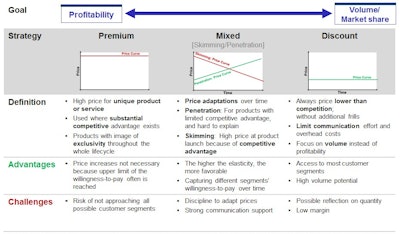
 Dr. Michael Marquardt
Dr. Michael Marquardt  Laszlo Horwitz
Laszlo Horwitz  Dr. Michael Scholl
Dr. Michael Scholl The Challenge of Choosing a Pricing Strategy
The rate of innovation in technology hardware has been accelerating over the past decades. However, a major challenge is defining an optimal launch pricing strategy to realize the new product’s full potential. If the launch price is set too high, the product will get rejected by the market; if on the other hand it is too low, potential profits will be lost - which can be difficult, if not impossible, to regain at a later stage. The Apple Macintosh Portable launch price, for instance, of $7,300 in 1989 was so high that it required a tremendous effort not only in re-designing and -branding into the PowerBook series but also by decreasing the price by over 70 percent until 1991 to turn the flop around.
So how can companies deduce the optimal pricing strategy for a launch, when there is no comparable solution in the market?
In many cases, the PLUS-Pricing Assessment helps innovating technology companies to focus their launch pricing while still being in the concept phase of product development. We explain how companies can conduct the PLUS-Pricing Assessment on their own to determine the accepted price range for a technology hardware launch product, develop launch pricing strategies and eventually get orientation with respect to production costs that will be covered by earnings.
PLUS-Pricing Assessment
The PLUS-Pricing Assessment [Chart 1] is a pragmatic and streamlined method in which the innovating hardware company Profiles the current market situation to understand the strength of the innovation’s value, Labels the next-best-solutions’ pricing to determine a reliable anchor price for the launch product, Understands potential customers to identify roughly their willingness-to-pay and Sets the launch pricing strategy and method to finalize product development in a focused manner.
 Chart 1: Structure of the PLUS-Pricing Assessment
Chart 1: Structure of the PLUS-Pricing AssessmentStep 1: Profile the current market situation
Precise market profiling is required in the first step for full market comprehension and transparency to deduce the options for price positioning of the product innovation relative to competition. If the product has clear advantages over and above next-best-solutions, then higher prices can be realized compared to the competition. On the other hand, if it has hard to explain or no advantages, then a lower price might be required to launch successfully. Therefore it is important to analyze the current and future customer needs and identify how they are being addressed by the innovation. A competitive analysis by screening the environment for next-best-alternatives helps identifying central (dis-)advantages of the innovation compared to the existing competition. This will serve to understand the strength of the value of the innovation, providing potential leverage for differentiation.
Step 2: Label next best pricing for reference
After gaining an impression on relative pricing options with respect to the next-best competition, it, of course, is necessary to approximate those alternatives’ price levels as a reference. Even without comparable products available, understanding the costs for actual next-best solutions currently fulfilling costumers’ needs can serve as such anchors. Here it is vital to talk to key opinion leaders (KOLs), such as association chairs or researchers knowing the targeted market very well. They will be able to provide close estimations of reliable market potentials. These expert discussions are further valuable in verifying market success factors, entrance hurdles and must-have/outstanding features to ensure the innovation contains the advantages found by profiling the market situation.
Step 3: Understand potential customers
In the third step the customer is put center-stage. Relevant buying centers (e.g. boards within customers’ organization deciding on investments) will be identified and key persons approached for further interviews. The goal is to narrow down the willingness-to-pay in the market and deduce an accepted price corridor. Here, van-Westendorp Method serves as an effective tool. Potential customers are asked four questions: ‘For the following product (i.e. technology hardware innovation), what price do you perceive as (1) too expensive, (2) too cheap, (3) expensive and (4) reasonable?’ The cumulative curves of responses are plotted for each question with the intersections providing top and low price limits as well as the penetration and indifference prices.
This allows for a possible re-orientation of the innovation process and guides the launch with respect to characteristics to leverage in terms of pricing and marketing. Ultimately, revenue expectations can be used for comparison with predicted costs and accordingly decide on most profitable product configuration.
Step 4: Set launch strategy
The final step of the PLUS-Pricing Assessment will set the launch pricing strategy. Based on the qualitative and quantitative insights gained in the first three steps, the innovating company can select between four possible options [Chart 2]:
- Premium pricing: In case of a substantial competitive advantage with unique characteristics, a premium price can be charged to reap-off the pioneer-profit and build up a strong brand which will allow the innovation to be protected against later replicates as done with the iPhone flagship model which is following a premium price strategy until being replaced by a newer model
- Skimming: Sequentially pricing the innovation, charging a premium price at product launch to take advantage of the higher willingness-to-pay of early movers, to afterwards reduce the price in order to capture the lower willingness-to-pay of the large masses and gain market share as is commonly done with video game consoles
- Penetration: A pricing strategy for products where the competitive advantages are hard to explain. This strategy is particularly useful to initiate word of mouth and attract customers away from competitors, allowing for later price increases and building on customer loyalty as was done by Samsung when entering the smartphone market
- Discount: In absence of competitive advantages, rapid market share can be gained by pricing the product below the competition, targeting the price sensitive customers. This strategy is particularly interesting for firms where the cost of production declines sharply due to economies of scale or a learning-curve effect as volume expands. An example is Xiaomi’s TV becoming the best-selling flat-screen model in China’s e-commerce market by being offered cheaper than the competition.
 Chart 2: Overview pricing strategies
Chart 2: Overview pricing strategiesWithin the set pricing strategy, the innovating company also needs to decide on the appropriate pricing model. Examples include subscription-based pricing, pay-per-user, pay-per-usage, flatrate and many others. Smaller firms typically prefer pay-per-usage/user as they require transparency of their costs. Larger firms, on the other hand, frequently need flatrate models, as it allows for higher budget security. It is therefore crucial to take the customer constraints from the discussions into consideration as they will have a profound impact on product launch success (e.g., annual budget limitations for high upfront costs).
Clear Vision Ahead
As the technology hardware market continues to evolve and the market demands more innovation, companies must find effective ways to understand the value of their product to tailor it to market needs while maximizing profitability. Through the PLUS-Pricing Assessment, companies will gain market transparency and clarity on their potential customers’ willingness-to-pay before finalizing their product. Accordingly, innovating companies will be able to set the launch pricing strategy and model with a defined price corridor. Together, these set the foundation for a later test of the optimal price points (e.g., conjoint analysis) once the product innovation is finalized and ready for launch.
Dr. Michael Marquardt is a Project Manager, Laszlo Horwitz is a Consultant and Dr. Michael Scholl is the managing director and partner at Homburg & Partner.






















